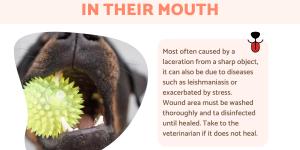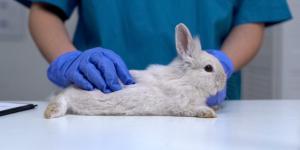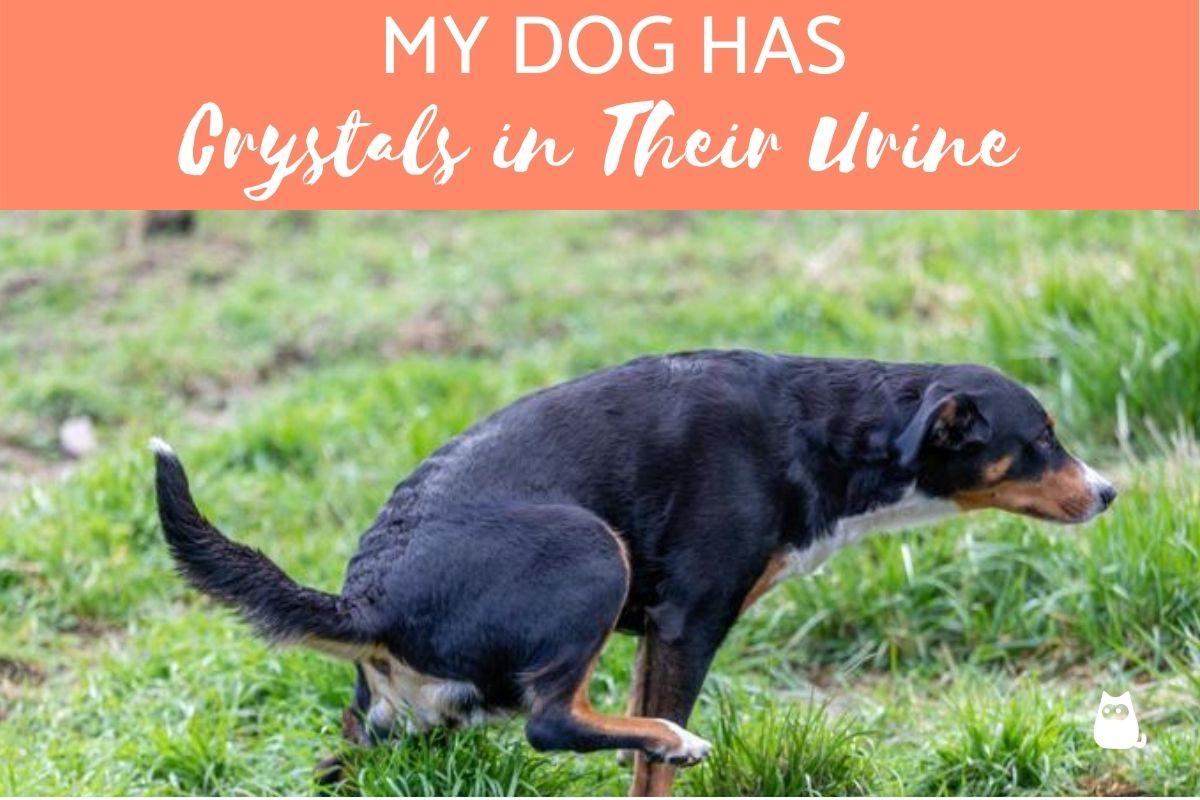My Dog Has Crystals in Their Urine



See files for Dogs
Since we take our dogs out for walks and witness them urinate, we might notice there is something different about their urine. While we need to ensure it is not something that was already on the ground, crystals in the dog's urine are a worrying. This is because they may indicate the presence of bladder stones which are too big to pass normally. Such blockages can cause serious health problems, not to mention discomfort in the animal.
In this AnimalWised article on my dog has crystals in their urine, we look at the different types of crystals they may be, what causes them and how to treat bladder stones. We also look at how diet might reduce the formation of crystals in the future.
Causes of crystals in dog urine
Crystals in a dog's urine are a sign of bladder stones (scientifically known as uroliths), of which there are various types. The underlying cause, however, will depend on the type of stone. We describe these in more detail below, but here we look at some of the general causes of crystals in dog urine:
- Urinary tract infection (UTI): when a bacterial infection is present in the urinary tract, they can produce an enzyme known as urease. Urease breaks down urea which can produce excess ammonia, making the urine more alkaline. Combined with inflammation from the infection, this creates an environment which promotes the formation of crystals around impurities present in the urine. Cystitis is a type of bladder infection (and, therefore, a UTI) which is most common.
- Metabolic disease: various metabolic diseases can increase the excretion of certain minerals into the urinary tract via the bladder. When they accumulate, crystals can form.
- Dehydration: whether as a symptom of an underlying disease or simply the dog is not drinking enough water, dehydration can concentrate the urine and increase the rusk of UTIs. This promotes the create of crystals and bladder stones.
- Diet: a poor diet means the dog may be eating too many nutrients which aren't suitable. Otherwise healthy minerals provided in excess can lead the dog to form crystals. Also, if a dog is overeating they may accumulate too many minerals. If we give the dog too many treats, it increases this risk.
- Other diseases: certain diseases which affect the urinary tract such as kidney and liver diseases can cause the build up of mineral deposits. When the blood contains too much calcium, for example, this can lead to certain types of uroliths.
It is believed that some dogs have a greater genetic predisposition toward developing uroliths. The reasons are not well understood, but the breeds more likely to have crystals in their urine are:
- Dalmatian
- Standard and Miniature Schnauzer
- Mini Poodle
- Bichon Frize
- Cocker Spaniel
- lhasa Apso
- Yorkshire Terrier
- Shih Tzu
- German shepherd
- Dachshund
- Bulldogs
- Golden Retriever
- Labrador Retriever
Symptoms of crystals in dog urine
The urine crystals can lodge in any part of the urinary tract. This includes the bladder and the urethra, although in the latter to a lesser extent. Regardless of the type of urolith, they can cause hematuria. This is when there is blood present in the dog's urine. This is likely due to physical trauma the crystals cause to the tissues of the urinary tract.
When the crystals develop into larger bladder stones, their size can cause blockages. This can make it difficult for the dog to urinate or may prevent urination altogether. In turn, this can lead to the following symptoms:
- Pain when trying to urinate
- Small amounts of urine produced
- Adopting the position of urination, but not completing it
- Urine leakage from urethra
- Vomiting
- Losing apetite
In advanced cases, the pain caused by bladder stones affects their well-being. They may vomit due to discomfort or not be able to eat at all. These symptoms require immediate veterinary attention.
Diagnosis of uroliths in dogs
The vet can detect crystals in dog urine by taking a sample and examining it under a microscope. We may need to take the urine sample ourselves, so we will likely be given the sterile equipment to do so. If we cannot do it, the dog may be taken into observation until the sample is collected. We will also need to remember any other symptoms or behavioral change and report them to the vet.
During the urinalysis, the vet will likely test the pH levels. This will help them to know which type of crystal is causing the stones. They will also determine this from the shape, size and color of the crystals. If crystals are found, the veterinarian will likely confirm the diagnosis using an x-ray, ultrasound or both.

Types of crystals in dog urine
The different types of canine urine crystals are caused by different types of build up and deposits. The type of deposit will determine the type of urolith. They include:
- Struvite: the most common type of bladder stone in dogs, struvite crystals contain phosphate, ammonia and magnesium. They are associated with UTIs thanks the to excessive ammonia created. They have a characteristic rectangular or coffin shape when viewed under a microscope.
- Calcium oxalate: along with struvite, these are some of the most common types of urine crystal in dogs. Some bladder stones may be created together with others, depending on the cause.
- Ammonium urate: these crystals are derived from uric acid, meaning they will occur when the urine is acidic or neutral. This is one of the reasons for the testing the pH levels of the urine sample.
- Cystines: these are hexagonal in shape, transparent and also associated with neutral or acidic urine.
- Silicon or calcium phosphate: the presence of these crystals in dog urine is relatively rare.
As you can see the type of urolith created is dependent on the type of mineral, but there are other factors. These include the urine's pH level, the temperature of the urine, the pH level and the degree of solubility of a given crystal type.
Treatment for crystals in dog urine
The treatment will depend on the type of crystal that is causing the discomfort. This is why achieving the correct diagnosis is essential. In the case of struvite crystals, medication will likely be prescribed to reduce the ammonia levels. In addition, a special diet will be prescribed to help dissolve the crystals and allow them to be passed.
For calcium oxalate crystals, dissolving the uroliths through diet is difficult. In certain cases, surgical intervention is required to remove the crystals physically. This operation may also be used for struvite or any other type of crystal which cannot be expelled via the urethra. Some may even remain in the bladder if the buildup is acute. A diet change will likely be implemented also as a preventive measure.
Additionally, to help the dog pass the stones, they will need to be given more opportunities to urinate. The longer urine spends in the bladder, the more crystals can precipitate. Any secondary symptoms will also be treated. For example, if the cause of the bladder stones is infection, they will likely be given antibiotic treatment. Further follow-up tests will likely be carried out for early detection of new crystals.

Diet for dogs with bladder stones
Some crystals, such as struvite, ammonium urate, or cystine, can be dissolved by changing the dog's diet. In these cases, the dog food for crystals in urine will be specially formulated to treat this problem. There are commercial brands with a special formula created for dogs with urinary crystals. However, you should check with the veterinarian for their recommendation.
The diet can also be used as a preventive for further crystals, so check with the vet if it is best to make a permanent change. Otherwise, it will likely only be needed for a few weeks. When ammonium urate or cystine crystals are diagnosed, eating offal will need to be avoided.
In the case you want to create a homemade diet for dogs with urinary crystals, egg protein and vegetables are recommended. However, you will still need to meet their other dietary requirements, especially if they have underlying conditions. if you want to make a homemade diet for the dog, you will need to speak to your veterinarian to ensure the animals needs are met.
Proper hydration is also vital for a dog with urinary crystals since concentrated urine is a contributing factor. Ensure the dog has access to clean fresh water 24 hours a day. For dogs which do not drink much water, you can help them drink more by soaking their feed in water before they eat. Taking care of our dog's diet is essential for every animal, not just those suffering from bladder stones. This includes those who want to provide natural or BARF diets for their dog.
Our video below will also show you some BARF food recipes which may be helpful if the vet advises it:

This article is purely informative. AnimalWised does not have the authority to prescribe any veterinary treatment or create a diagnosis. We invite you to take your pet to the veterinarian if they are suffering from any condition or pain.
If you want to read similar articles to My Dog Has Crystals in Their Urine, we recommend you visit our Other health problems category.
- Carlson, & Giffin. (2002). Practical manual of canine veterinary medicine. Madrid: Editorial el Drac.
- Lulich, J., et al. (2016). ACVIM Small Animal Consensus Recommendations on the Treatment and Prevention of Uroliths in Dogs and Cats. Journal of Veterinary Internal Medicine, 30(5), 1564-1574.







